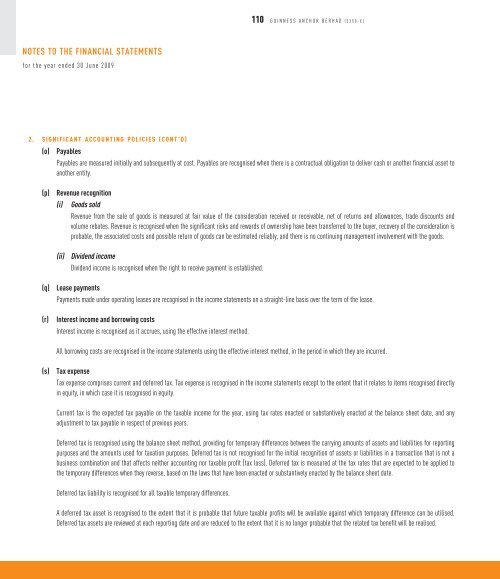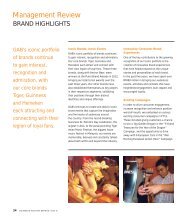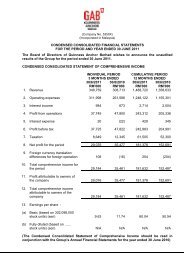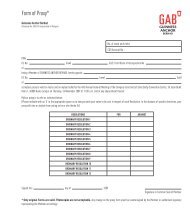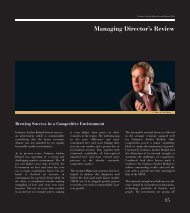Full Version Guinness Anchor Berhad Annual Report 2009 - Gab
Full Version Guinness Anchor Berhad Annual Report 2009 - Gab
Full Version Guinness Anchor Berhad Annual Report 2009 - Gab
Create successful ePaper yourself
Turn your PDF publications into a flip-book with our unique Google optimized e-Paper software.
110 GUINNESS ANCHOR BERHAD (5350-X)<br />
NOTES TO THE FINANCIAL STATEMENTS<br />
for the year ended 30 June <strong>2009</strong><br />
2. SIGNIFICANT ACCOUNTING POLICIES (CONT’D)<br />
(o) Payables<br />
Payables are measured initially and subsequently at cost. Payables are recognised when there is a contractual obligation to deliver cash or another financial asset to<br />
another entity.<br />
(p)<br />
Revenue recognition<br />
(i) Goods sold<br />
Revenue from the sale of goods is measured at fair value of the consideration received or receivable, net of returns and allowances, trade discounts and<br />
volume rebates. Revenue is recognised when the significant risks and rewards of ownership have been transferred to the buyer, recovery of the consideration is<br />
probable, the associated costs and possible return of goods can be estimated reliably, and there is no continuing management involvement with the goods.<br />
(ii)<br />
Dividend income<br />
Dividend income is recognised when the right to receive payment is established.<br />
(q)<br />
(r)<br />
Lease payments<br />
Payments made under operating leases are recognised in the income statements on a straight-line basis over the term of the lease.<br />
Interest income and borrowing costs<br />
Interest income is recognised as it accrues, using the effective interest method.<br />
All borrowing costs are recognised in the income statements using the effective interest method, in the period in which they are incurred.<br />
(s)<br />
Tax expense<br />
Tax expense comprises current and deferred tax. Tax expense is recognised in the income statements except to the extent that it relates to items recognised directly<br />
in equity, in which case it is recognised in equity.<br />
Current tax is the expected tax payable on the taxable income for the year, using tax rates enacted or substantively enacted at the balance sheet date, and any<br />
adjustment to tax payable in respect of previous years.<br />
Deferred tax is recognised using the balance sheet method, providing for temporary differences between the carrying amounts of assets and liabilities for reporting<br />
purposes and the amounts used for taxation purposes. Deferred tax is not recognised for the initial recognition of assets or liabilities in a transaction that is not a<br />
business combination and that affects neither accounting nor taxable profit (tax loss). Deferred tax is measured at the tax rates that are expected to be applied to<br />
the temporary differences when they reverse, based on the laws that have been enacted or substantively enacted by the balance sheet date.<br />
Deferred tax liability is recognised for all taxable temporary differences.<br />
A deferred tax asset is recognised to the extent that it is probable that future taxable profits will be available against which temporary difference can be utilised.<br />
Deferred tax assets are reviewed at each reporting date and are reduced to the extent that it is no longer probable that the related tax benefit will be realised.


